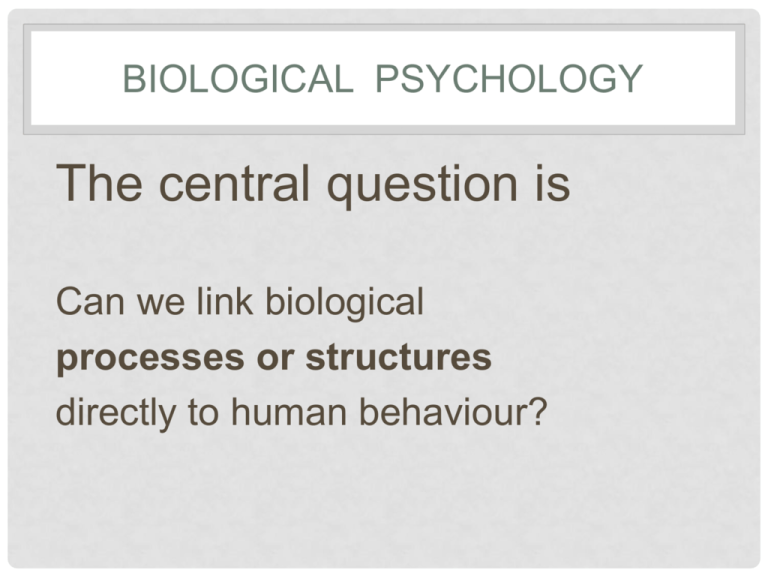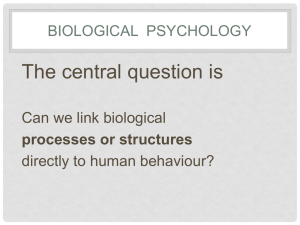raine et al (1997) brain abnormalities in murderers
advertisement

BIOLOGICAL PSYCHOLOGY The central question is Can we link biological processes or structures directly to human behaviour? BIOLOGICAL PSYCHOLOGY • Research suggests that brain dysfunction may PREDISPOSE a person to being violent • The FRONTAL brain region may be associated with violent behaviour • Some violent offenders plead NGRI (not guilty by reason of insanity) to murder charges BIOLOGICAL PSYCHOLOGY • Discussion points • What are the advantages to the Biological explanation of behaviour? • What are the disadvantages? • Task: Read about your classic study Raine,1997 in your E-textbook and your old textbook (page 134). Go through slides 1-34 of this powerpoint. Make detailed notes on this study. Take the quiz http://www.holah.karoo.net/raine.htm to check your understanding. Be ready next lesson to show me your notes!! BIOLOGICAL PSYCHOLOGY RAINE • The Raine hypothesis is that some seriously violent individuals have localised brain damage in certain areas of the brain including the prefrontal cortex; the amygdala; the thalamus; the hippocampus; and the corpus callosum. Top tip: take time to get to know the ‘brain’ see I Learn for brain tutorials! BRAIN ABNORMALITIES IN MURDERERS INDICATED BY POSITRON EMISSION TOMOGRAPHY. ADRIAN RAINE, MONTE BUCHSBAUM, AND LORI LACASSE (1997) Typical Criminals? THE FRONTAL LOBE is important for voluntary and planned motor behaviours - such things as voluntary movement of the eyes, trunk, limbs and the many muscles used for speech Raine suggests three reasons why prefrontal deficits may cause antisocial personality: 1. The region appears to be critical for self-restraint and deliberate foresight. "One thing we know about antisocials is that they do not think ahead" 2. It’s crucial for learning conditioned responses e.g. a child learns to link the thought of a misdeed with anxiety over punishment. "Unconscious mental-emotional associations such as these lie at the core of what we call conscience" 3. Prefrontal deficits are associated with low levels of autonomic arousal. eople with Antisocial personality Disorder (APD) may unconsciously be trying to compensate by seeking stimulation "For some kids one way of getting an arousal-buzz is by robbing stores or beating people up” CORPUS CALLOSUM Is the enormous bundle of fibres which interconnects the left and right cerebral hemispheres. It disseminates information from the cerebral cortex on one side of the brain to the same region on the other side – it is a communication bridge . TEMPORAL LOBE (TEMP' OR UL) Various parts of it are important for the sense of hearing, for certain aspects of memory, and for emotional/affective behaviour. RAINE (1997) THE STUDY • The participants: • 41 murderers (39 males 2 females) • Charged with murder/manslaughter in California/USA • All pled NGRI • All were referred for physiological and psychological examination RAINE (1997) THE STUDY • The ‘histories’ • head injury/brain damage(23) • drug abuse (3) • affective disorder (2) • epilepsy (2) • hyperactivity & learning impairment (3) • personality disorder (2) • Schizophrenia (6) RAINE (1997) THE STUDY • CONTROL GROUP • 41 normal individuals (non murderers) • matched for sex and age • including 6 ‘murdering’ schizophrenics who were matched with 6 ‘ non murdering’ schizophrenics • IQ, ethnicity, brain injury not matched! RAINE (1997) THE STUDY • The method • A ‘natural’ experiment (quasi) using independent measures design where participants were matched on key criteria. • The procedure • PET Scans were used to examine the brain RAINE (1997) THE STUDY What does ‘PET’ as in PET scan mean? Positron Emission Tomography How does it work? This method assesses the amount of metabolic activity in various parts of the brain A scanning machine detects positrons which are emitted. High amounts are associated with a higher level of metabolic activity. RAINE ET AL (1997) BRAIN ABNORMALITIES IN MURDERERS PET scans showing ‘hot spots’ for cognitive activities RAINE ET AL (1997) BRAIN ABNORMALITIES IN MURDERERS PET scan of a subject whilst practicing a new language skill A scan of the same subject demonstrating this skill after it had become familiar PHYSIOLOGICAL PSYCHOLOGY RAINE • THE PET SCAN process • Patients are injected with fluorodeoxyglucose tracer (radioactive glucose) • For about 30 minutes before the PET SCAN the participants are engaged in a ‘continuous activity’ task • This activity aimed to activate the FRONTAL LOBES, and the RIGHT TEMPORAL and PARIETAL LOBES "Continuous Performance Task: Single digits (0-9) were presented for 40 ms at a rate of one every 2 seconds. Subjects were told to press a button using their right hand each time that they detected the digit 0 and that it was equally important to respond to zeros and not respond to non-zeros. Targets were presented irregularly with a probability of occurrence of 0.25. Stimuli were presented silently by rear projection on a 24 x 24 cm screen, with a Kodak carousel slide projector fitted with an Ilex No. 4 SynchroElectronic Shutter and blurred to a degree that makes digits barely recognizable (such that a 2.8 diopter correction is required to refocus clearly). The subject’s eyes were 1.2m from the rear projection screen.” FINDINGS • Both groups performed similarly on performance task • There were certain characteristics that were NOT CONTROLLED..i.e • 6 murderers were left handed • 14 murderers were non white • 23 murderers had history of head injury RAINE FOUND SOME SIGNIFICANT RESULTS • He suggested there was evidence for DIFFERENCES in the brains of the murderers • He found amongst other things LOWER ACTIVITY in some CORTICAL REGIONS of the brain ACTIVITY DEFICIT Raine's PET scans show greater activity (red regions) in the prefrontal cortex of a normal brain than in a murderer's brain. NORMAL MURDERER Diagrams from Raine’s research SUMMARY OF DIFFERENCES IN THE BRAINS OF THE MURDERERS Reduced activity in prefrontal cortex & corpus callosum The Left hemisphere showed less activity than the right Abnormal asymmetries in the amygdala PHYSIOLOGICAL PSYCHOLOGY RAINE Pre Frontal deficit - associated with impulsivity Amygdala - associated with aggressive behaviour Amygdala - reduced activity associated with fearlessness Corpus Callosum - dysfunction associated with predisposition to violence CONCLUSION It is unlikely that violence is due to a single brain mechanism There is evidence that - murderers pleading NGRI may have different brain functions to ‘normal’ people There is some evidence that murderers have different brain functions to psychiatric patients WHAT these findings DO demonstrate That there MAY BE a link between brain activity and a predisposition towards violence which should be investigated further WHAT THESE FINDINGS DO NOT DEMONSTRATE • That violent behaviour is ‘caused’ by brain pathology • That murderers are NOT RESPONSIBLE for their actions • That brain dysfunction causes violent behaviour EVALUATION ISSUES Is the research Valid? Areas of brain selected based on previous research but Could IQ differences be a factor? Is the research Reliable? Could the same technique be used on other people? ETHICS How might you criticise this study from an ethical point of view? Raine’s findings raise important ethical questions about culpability and free will. "To what extent, should we take disordered brain functioning into account as part of the reason for certain types of crime? “Assuming these people are not responsible for their own brain damage, should we hold them fully responsible for their criminal acts?" GENERALISATION Can the findings of this study be generalised to all murderers? Why or why not? Application - how is this study useful? INTERVENTIONS • Raine suggested a number of interventions that could be applied. • Cognitive and behavioural therapy and drug therapy. • Biofeedback – training children or adults to control their own arousal levels. • Children could be channelled into safe activities that might satisfy their natural stimulation-seeking and aggressive proclivities. QUESTIONS • Describe the strengths & weaknesses of the NATURAL (Quasi) experimental method. • What do you think might be the main difficulty in drawing conclusions from PET observed ‘brain activity’? Identify one thing that cannot be concluded from this study






